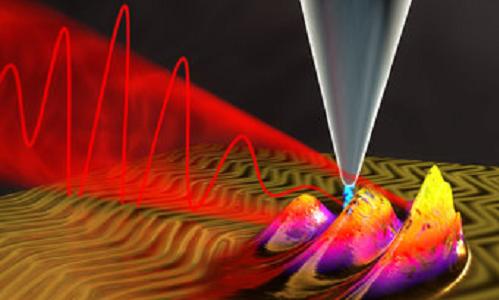Researchers, led by an Indian, have developed for the first time, a microscope for extremely fast processes that take place on the quantum scale.
New Delhi (ISJ): Control of electrical current forms the backbone of electronics. The capability to vary electronic current from a very small to a big value defines the speed of electronics. This speed is limited to GHz in contemporary electronics. However, when laser pulses can consistently control electrons in an electronic circuit, the frequency of manipulation goes up from present limited gigahertz (GHz) to 0.5 petahertz (PHz), which is nearly 1 million times faster.
This approach to control electronics with CEP stabilized laser pulses is known as ‘Light-wave-electronics’. Until now, all demonstrations of light-wave-electronics have been limited to microscale dimensions, the current may be generated in a nanostructure but its read out takes place at much bigger dimensions; atomic scale currents could not be read.
A team of scientists at Max Plank Institute of Solid State Research, Stuttgart, Germany lead by Dr. Manish Garg has developed, for the first time, a microscope for extremely fast processes that take place on the quantum scale.
This microscope – a sort of HD camera for the quantum world – allows the precise tracking of electron movements down to the individual atom. It should therefore provide useful insights when it comes to developing extremely fast and extremely small electronic components, for example.
With the new technique, physicists can now measure exactly where electrons are at a specific time down to the individual atom and to an accuracy of a few hundred attoseconds. For example, this can be used in molecules that have had an electron catapulted out of them by a high-energy pulse of light, leading the remaining negative charge carriers to rearrange themselves and possibly causing the molecule to enter into a chemical reaction with another molecule.
Moreover, the technique not only allows researchers to track the path of electrons through the processors and chips of the future, but can also lead to a dramatic acceleration of the charge carriers.
“With this turbo booster for light waves, we could clear the way for light-wave electronics, which is millions of times faster than current computers, Dr. Manish Garg told Indian Science Journal.
An attosecond is a billionth of a billionth of a second; in that time, light can only travel the length of a water molecule. For a number of years, physicists have used laser pulses of a sufficiently short length as an attosecond camera.
The technique has the potential to develop processors and chips for electronic gadgets of the future. Presently, electrons oscillate at a frequency of a billion hertz in computers, but using ultra-short light pulses, it may be possible to increase its frequency to a trillion hertz.
The research is still in the nascent stage and would take “huge efforts” to make it commercially viable. It requires further development based on the “proof-of-concept experiments” carried out by the scientists to reduce cost and make the technique more reliable. But it is “very important from both a fundamental and an applied perspective,” explained Dr. Garg.
“What we have done so far is only proof-of-concept studies, for real devices operating with our technique one has to wait probably a decade,” Dr. Garg added.
Dr. Garg and his research-partner Klaus Kern integrated two state-of-the art techniques scanning tunnelling microscopy and attosecond technology to achieve atomic scale resolution both in time and space. Attosecond technology is today’s top-shelf technology, which helps to observe events that last less than 100 attoseconds or quintillionths of a second .


